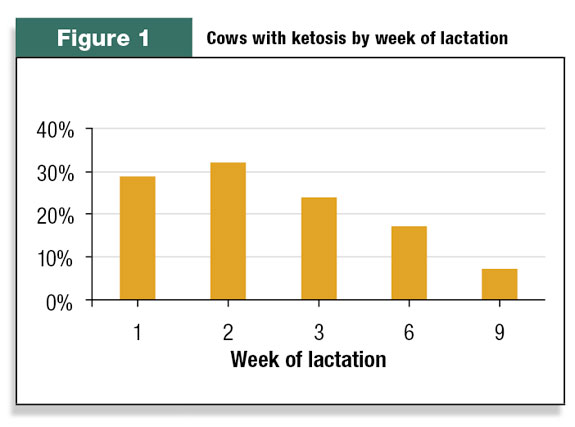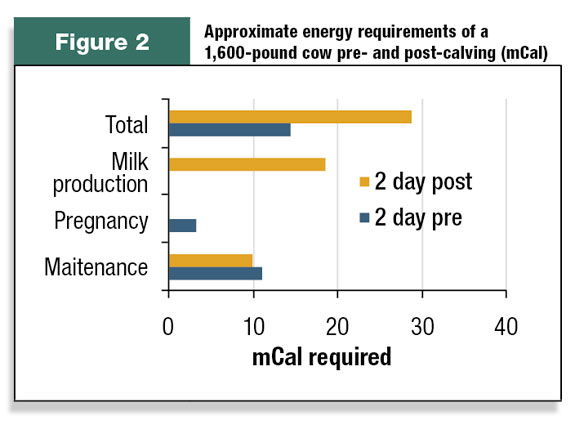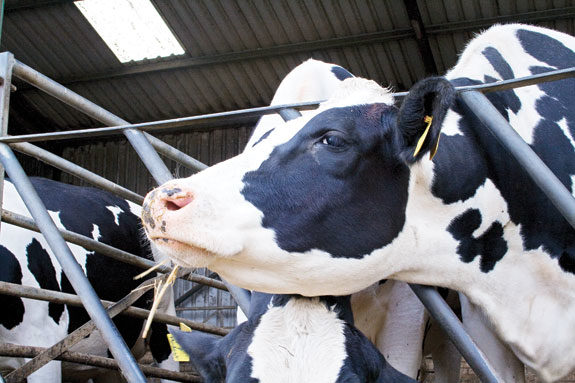If you answered “yes,” you should feel good about being proactive about this condition, knowing you can do something about it. If you answered “no” because you have actually tested for ketosis, you, too, can feel good about being proactive, but remember that testing should be an ongoing process. But if you answered “don’t know” or “haven’t tested,” keep reading. This article explains what ketosis is, its effects and why a dairy should be testing for it.
What is ketosis?
By definition, ketosis or hyperketonemia is a condition of abnormally high levels of ketones in the blood. In the dairy cow, the three major ketones are acetone, acetoacetate and betahydroxybutyrate (BHB).
Clinically, ketosis is associated with a decrease in dry matter intake, body condition loss and a drop in milk production. Occasionally, nervous signs are present, and the cow’s breath may smell sweet like acetone.
Sub-clinical ketosis (SCK) has been defined as elevated levels of ketone bodies without the presence of clinical signs. Although the term SCK has become popular due to recent interest in the subject, it may not be the best term, because clinical signs and ramifications do occur.
However, these clinical signs typically occur later or are difficult to detect. For the purpose of this article, ketosis will be the term used for elevated ketones with or without clinical signs at the time diagnosis is made.
This approach has merit because more and more dairies are testing for ketosis and making a positive or negative declaration. Thus, the diagnosis is based on test results and not on clinical signs the cow may or may not be exhibiting.
How common is ketosis?
Good question! Occurrence of this disease varies across herds, and additional variation is brought about by differences in definition of ketosis as well as differences in recording procedures.
For example, on some dairies a cow may be termed “ketotic” only when she is treated for clinical signs. In such cases additional variation enters the equation – the person or persons making the diagnosis and how that diagnosis is being made.
Even if the definition and diagnostic procedure is standardized within a population of herds, results still need to be recorded uniformly in the recordkeeping system in order to make valid comparisons within the population.
Not all dairies record every single event, particularly if no action is taken on the cow. And not every person testing follows the same procedure – especially if the dairy has no standardized protocol. On many dairies, the person making the diagnosis of ketosis may be far removed from the person entering data into the system.
Such discrepancies in definition, procedures and recording make it difficult to draw reliable conclusions regarding ketosis simply by looking at a dairy’s records.
Several research studies have evaluated the prevalence of ketosis using standardized definitions. Dohoo and Martin found the prevalence of ketosis in 32 herds to range from zero to about 34 percent in the first 65 days using a nitroprusside-based milk powder test.

Duffield and co-workers tested cows weekly in 25 dairy herds and found cumulative prevalence over 50 percent using blood BHB levels greater than 1200µmol/L (12.5mg/dl) as their definition for ketosis. (See Figure 1 .)
In a recently published study evaluating 60 freestall herds in the northeastern U.S., 40 percent of those herds had more than 15 percent of cows testing positive for ketosis using blood BHB greater than 12mg/dl (~1153µmol/L) as the definition for ketosis.
These studies illustrate that ketosis is prevalent in the dairy industry.
What causes ketosis?
There are basically two causes of ketosis, one associated with production of ketone bodies in the liver and the other from consumption of butyric acid in silage in which excess butyrate crosses the rumen wall, is carried to the liver by the blood and is converted to BHB. Production of ketone bodies in the liver is associated with negative energy balance, which occurs in essentially all cows during early lactation.

Milk production in the udder (lactogenesis) requires large amounts of glucose. The cow’s demand for glucose nearly doubles by the second day of lactation compared to just prior to lactation. (See Figure 2 .)
Relatively small amounts of glucose are taken up by the cow’s gut because the rumen ferments most of the potential glucose in the diet into volatile fatty acids.
As a result, glucose must be produced by the liver in a process called gluconeogenesis.
Rumen fermentation of carbohydrates results in the production of volatile fatty acids, the most important of these being acetate, propionate and butyrate.
Propionate accounts for about a third of the energy from fermented carbohydrates; the rest being other volatile fatty acids.
Because propionate is the only fatty acid capable of supporting gluconeogenesis, it is essential cows increase their dry matter intake rapidly after calving to support propionate production.
Acetate, butyrate and fat in the form of nonesterified fatty acids (NEFA) mobilized from the cow’s body reserves are useful energy sources for other organs, but are not a source of glucose for milk synthesis.
A healthy cow at four days of lactation has net energy of lactation (NEL) requirements exceeding NEL intake by more than 25 percent. Thus, all cows have some degree of negative energy balance, yet not all cows get ketosis.
In the early-lactation cow, reduction of dry matter intake as well as the associated stress around calving will increase the NEFA in the blood. When negative energy balance increases at calving and shortly following, the concentration of NEFA is increased.
NEFA is removed from the blood in proportion to its concentration, therefore the more NEFA in the blood, the more available to the liver. Once NEFA is presented to the liver, it essentially has three fates:
1. oxidization in the liver, providing energy to the liver
2. partial oxidation resulting in ketone body formation
3. reconversion to triglyceride, which may result in fatty liver
Ketones can be utilized as a source of fuel for many tissues such as muscle, thereby sparing glucose for lactogenesis. Ketone body formation is useful not only as an energy source but may also provide a protective mechanism against fatty liver.
Since all cows experience some degree of negative energy balance, the formation of ketone bodies is likely in all cows to some extent. However, levels too high or high too long indicate the cow has not made a successful transition from negative energy balance. PD
References omitted due to space but are available upon request to editor@progressivedairy.com .
PHOTO
Since all cows experience some degree of NEB, the formation of ketone bodies is likely in all cows to some extent. Photo by PD staff.

-
David L. Prentice
- Technical Consultant – Dairy
- Elanco Animal Health
- Email David L. Prentice







